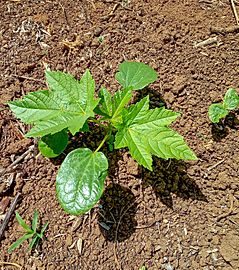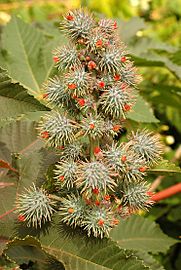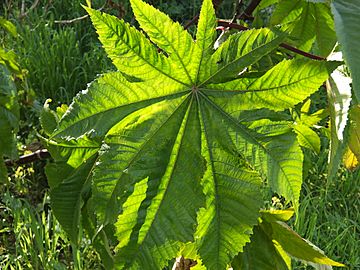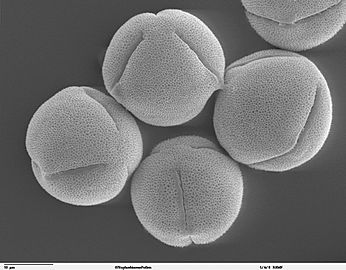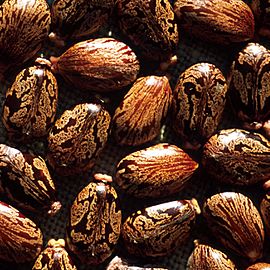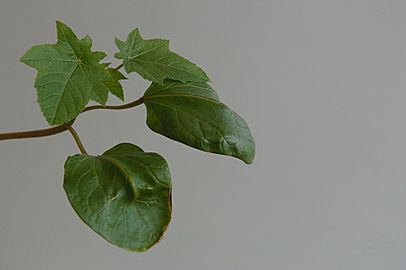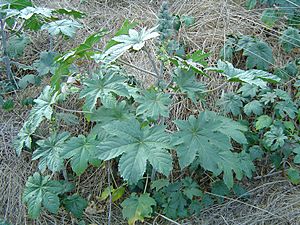Ricinus facts for kids
Quick facts for kids Ricinus |
|
|---|---|
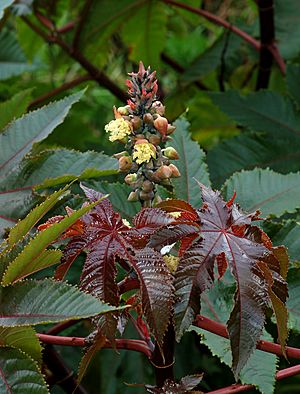 |
|
| Leaves and inflorescence (male flowers below female flowers) | |
| Scientific classification | |
| Genus: |
Ricinus (plant)
|
| Species: |
communis
|
The Ricinus communis, also known as the castor bean or castor oil plant, is a type of flowering plant that lives for many years. It belongs to the Euphorbiaceae family, also called the spurge family. This plant is the only species in its group, called Ricinus. Scientists are still studying how the castor plant evolved and how it relates to other plants using modern genetic tools. It can pollinate itself or be pollinated by wind or insects.
The plant's seed is called the castor bean. Even though it's called a "bean," it's not a true bean like those from the Fabaceae family. The castor plant originally comes from the southeastern Mediterranean Basin, Eastern Africa, and India. Today, you can find it growing all over tropical areas. People also grow it as a beautiful ornamental plant in many other places.
Castor seeds are where we get castor oil, which has many different uses. The seeds are full of oil, usually between 40% and 60%. This oil is rich in fats, especially one called ricinolein. However, the seeds also contain a very strong, water-soluble toxin called ricin. This toxin is also found in smaller amounts throughout the rest of the plant.
There's a plant called "false castor oil plant," Fatsia japonica, but it's not closely related to the true castor plant.
Contents
What the Castor Plant Looks Like
The Ricinus communis plant can look very different depending on where it grows and what type it is. Plant breeders have made many different kinds of castor plants, choosing them for their leaf and flower colors, and for how much oil they produce. It's a fast-growing shrub that sends up new shoots from its base. It can even grow as tall as a small tree, reaching about 12 meters (39 feet) high. However, it doesn't do well in cold weather.
Its shiny leaves are large, about 15 to 45 centimeters (6 to 18 inches) long. They have long stalks and are arranged alternately on the stem. Each leaf looks like a hand with five to twelve deep, jagged sections. Some types of castor plants have dark reddish-purple or bronze leaves when they are young. These leaves slowly turn dark green as they get older, sometimes with a reddish tint. Other types have green leaves from the start. In some varieties, a special color hides the green parts of the plant, like the leaves, stems, and young fruit. This makes them stay a dramatic purple to reddish-brown throughout the plant's life. Plants with dark leaves can grow right next to those with green leaves. This suggests that just one gene might control this color in some varieties. The stems and the round, spiny seed capsules also have different colors. The fruit capsules of some types are even more colorful than the flowers!
The flowers of the castor plant don't have petals. They are unisexual, meaning each flower is either male or female, but both types grow on the same plant. The male flowers are many, yellowish-green, and have noticeable creamy stamens (the parts that produce pollen). The female flowers grow at the tips of the spikes. They are fewer in number and have noticeable red stigmas (the parts that receive pollen). These female flowers are found inside the young, spiny capsules.
The fruit is a spiny, greenish (or reddish-purple) capsule. Inside, it holds large, oval, shiny, bean-like seeds. These seeds are very poisonous and have different brownish patterns. Castor seeds have a bumpy part called the caruncle. This caruncle is a type of elaiosome, which helps ants carry and spread the seeds.
-
Cotyledons (round) and first true leaves (serrated) on a young plant (about four weeks old)
How the Castor Plant Got Its Name
Carl Linnaeus, a famous scientist, named the plant Ricinus. This is a Latin word for "tick." He chose this name because the castor seed has markings and a bump at one end that look like certain ticks. There's also a group of insects called Ricinus in zoology, which are parasites of birds. This is allowed because animal and plant names follow different rules.
The common name "castor oil" probably came from its use as a replacement for castoreum. Castoreum is a perfume ingredient made from the glands of a beaver (which is called castor in Latin). The plant also has another common name, palm of Christ, or Palma Christi. This name comes from the belief that castor oil could heal wounds and cure illnesses.
Castor Plant in Nature
The Ricinus communis plant is a host plant for several insects. These include the common castor butterfly (Ariadne merione), the eri silkmoth (Samia cynthia ricini), and the castor semi-looper moth (Achaea janata). The larvae (caterpillars) of other Lepidoptera species, like Hypercompe hambletoni and the nutmeg moth (Discestra trifolii), also eat this plant. A jumping spider called Evarcha culicivora has a special connection with R. communis. These spiders drink the plant's nectar for food and prefer to use these plants for their courtship rituals.
Growing Castor Plants
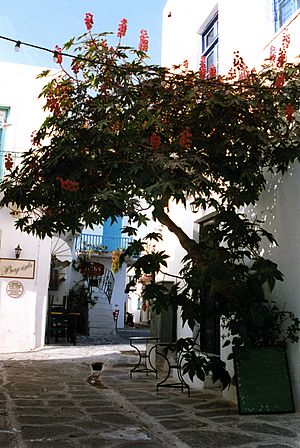
Even though Ricinus communis originally came from the southeastern Mediterranean Basin, Eastern Africa, and India, it now grows widely in tropical areas. In places with the right climate, the castor plant can easily grow on its own, sometimes even becoming an invasive plant in unused land.
It is also often used as a decorative plant in parks and other public spaces. If you plant the seeds early, indoors, and keep them warm (around 20°C or 68°F) until you plant them outside, the castor oil plant can grow to a height of 2 to 3 meters (6.5 to 10 feet) in just one year. In areas where there is frost, it usually grows shorter and is treated like an annual plant (meaning it lives for only one growing season). However, it can grow well outdoors in cooler climates, like southern England. In sheltered spots, its leaves don't seem to get damaged by frost, and the plant stays green all year. It was even used in parks in Toronto, Canada, a long time ago. Although it's not grown as a crop there, the plant grows wild in the US, especially in Griffith Park in Los Angeles.
Different Types of Castor Plants
Plant breeders have created different types of castor plants for two main reasons: to be used as ornamental (decorative) plants or for producing castor oil. The heights mentioned below are for plants grown for one year.
- Ornamental Types
- 'Carmencita' has won an award for being a great garden plant.
- 'Carmencita Bright Red' has red stems, dark purplish leaves, and red seed pods.
- 'Carmencita Pink' has green leaves and pink seed pods.
- 'Gibsonii' has reddish-tinged leaves with reddish veins and bright scarlet seed pods.
- 'New Zealand Purple' has plum-colored leaves with a red tint, and plum-colored seed pods that turn red when they ripen.
- (All the types above grow to about 1.5 meters (5 feet) tall when grown for one year.)
- 'Impala' is a compact type, only about 1.2 meters (4 feet) tall, with reddish leaves and stems that are brightest on the young shoots.
- 'Red Spire' is tall (2 to 3 meters or 6.5 to 10 feet) with red stems and bronze leaves.
- 'Zanzibarensis' is also tall (2 to 3 meters or 6.5 to 10 feet), with large, mid-green leaves (about 50 centimeters or 20 inches long) that have white lines in the middle.
- Types for Oil Production
- 'Hale' was created in the 1970s for Texas, USA. It's short (up to 1.2 meters or 4 feet) and produces many flower clusters.
- 'Brigham' is a type adapted for Texas, USA, with less ricin toxin. It grows up to 1.8 meters (6 feet) and has only 10% of the ricin found in 'Hale'.
- 'BRS Nordestina' was developed in Brazil in 1990 for harvesting by hand and for dry environments.
- 'BRS Energia" was developed in Brazil in 2004 for harvesting by machines or by hand.
- 'GCH6' was developed in India in 2004. It can resist root rot and is tolerant to a plant disease called fusarium wilt.
- 'GCH5' was developed in India in 1995. It can resist fusarium wilt.
- 'Abaro' was developed in Ethiopia for harvesting by hand.
- 'Hiruy' was developed in Ethiopia for harvesting by hand during 2010/2011.
Allergies and Dangers
The Ricinus plant can cause very strong allergic reactions. It has a high allergy rating of 10 out of 10 on the OPALS allergy scale. The plant is also a major trigger for asthma, and allergies to Ricinus are common and can be severe.
The castor oil plant produces a lot of very light pollen. This pollen easily floats in the air and can be breathed into the lungs, causing allergic reactions. The sap (liquid inside the plant) can cause skin rashes. People who are allergic to the plant can also get rashes just from touching the leaves, flowers, or seeds. These people might also have allergic reactions to latex sap from the related Hevea brasiliensis plant (the rubber tree).
The danger of raw castor beans comes from the ricin they contain. While it's thought that eating four to eight seeds can be deadly for adults, actual cases of poisoning are quite rare. According to the Guinness World Records, the castor plant is the world's most poisonous common plant. If someone takes too much ricin, symptoms can include feeling sick, diarrhea, a fast heartbeat, low blood pressure, and seizures. These symptoms can last for up to a week. The poison can be taken out of castor beans using a complex process, similar to how cyanide is taken from almonds.
If ricin is swallowed, symptoms usually start within two to four hours, but they can sometimes be delayed for up to 36 hours. These symptoms include a burning feeling in the mouth and throat, stomach pain, vomiting, and bloody diarrhea. After several days, there can be severe dehydration and a drop in blood pressure. If not treated, death can occur within 3–5 days. However, in most cases, people can make a full recovery.
Poisoning happens when animals, including humans, eat broken castor beans or chew the seed. Whole, unbroken seeds might pass through the body without releasing the toxin. The toxin helps protect the castor oil plant from insect pests like aphids. Ricin has been studied for its possible use as an insecticide (bug killer). The castor oil plant is also a source of undecylenic acid, which is a natural fungicide (something that kills fungi).
It's important to know that commercially available castor oil, which has been processed, is not dangerous to humans in normal amounts, whether used internally or externally.
Uses of the Castor Plant
Castor oil has many uses in medicine and other areas. In laboratory tests, an alcohol extract from the plant's leaf was shown to protect the liver of rats from damage caused by certain poisons. Extracts from Ricinus communis leaves were also tested against eight harmful bacteria in rats and showed properties that could fight germs.
The outer part of the Ricinus fruit affected the central nervous system in mice at low doses. At high doses, mice died quickly. A water extract from the root bark showed pain-relieving effects in rats. Properties that fight allergies and inflammation were found in an extract from the root bark. Castor oil, along with the plant's roots and leaves, is used in the ancient Indian medical system of Ayurveda for various illnesses. It has also been studied for its possible use as a herbal medicine to reduce pain and inflammation.
Modern Commercial Uses
Around two million tons of castor seeds are produced globally each year. The main countries that produce castor seeds are India (which grows over three-quarters of the world's supply), China, and Mozambique. It is also widely grown as a crop in Ethiopia. There are several ongoing programs to develop new types of castor plants.
| Country | Production (Tonnes) | Footnote | ||
|---|---|---|---|---|
| India | 1,196,680 | |||
| Mozambique | 85,089 | F | ||
| China | 36,000 | * | ||
| Brazil | 16,349 | |||
| Ethiopia | 11,157 | * | ||
| Vietnam | 7,000 | * | ||
| South Africa | 6,721 | F | ||
| Paraguay | 6,000 | * | ||
| Thailand | 1,588 | * | ||
| Pakistan | 1,107 | * | ||
| World | 1,407,588 | A | ||
| No symbol = official figure, F = FAO estimate, * = Unofficial/Semi-official/mirror data, A = Aggregate (may include official, semi-official or estimates) |
||||
Other modern uses for castor oil include:
- Castor oil, whether natural, mixed, or changed chemically, is still very useful. For example, it's important as a special lubricant that doesn't freeze, fights germs, and can handle high pressure. It's used for things made of latex or metals, or as a part of fuels.
- Products from castor plants are used to make various chemicals.
- In Brazil, castor oil (known as mamona oil) is a raw material for some types of biodiesel fuel.
- In rural areas, children use the many seeds for slingshot balls because they have the right weight, size, and hardness.
- Because castor seeds have attractive patterns, they are popular for making inexpensive jewelry like necklaces and bracelets.
- Castor oil has been used on the skin for a long time to prevent dryness. It is still an ingredient in many cosmetics, either in its pure form or after processing.
- The high amount of ricinoleic acid in castor oil and its related products stops many microbes, including viruses, bacteria, and fungi. Because of this, they are useful ingredients in many ointments and similar preparations.
- Castor oil is the main raw material for polyglycerol polyricinoleate. This substance improves how cocoa butter flows when making chocolate bars, which helps reduce costs.
- In the US, castor oil is used to keep moles and voles away from lawns.
Historical Uses
Ancient Times
Castor seeds have been found in Egyptian tombs that are 4000 years old. The oil, which burned slowly, was mostly used to light lamps. Herodotus and other Greek travelers wrote about using castor seed oil for lighting, body lotions, and to make hair grow better and look nicer. It is said that Cleopatra used it to make the whites of her eyes brighter. The Ebers Papyrus, an ancient Egyptian medical text from 1552 BC, describes castor oil as a laxative (something that helps you go to the bathroom).
In India, the use of castor bean oil (eranda) has been recorded since 2000 BC. It was used in lamps and in local medicine as a laxative and a strong cleansing agent in Unani, Ayurvedic, Siddha, and other traditional medical systems. Traditional Ayurvedic and Siddha medicine considers castor oil the best medicine for curing arthritis diseases. It is regularly given to children to treat infections caused by parasitic worms. Modern medical research suggests that the cleansing action of castor oil helps clear parasites from the intestines.
The ancient Romans used both the seeds and leaves of Ricinus communis for various medical and cosmetic purposes. The naturalist Pliny the Elder noted that the seeds were poisonous. However, he mentioned they could be used to make wicks for oil lamps (perhaps if crushed) and the oil could be used as a laxative and lamp oil. He suggested using the leaves for different types of swelling. Also, if boiled by themselves and applied to the face for three days in a row, they could improve a person's skin.
In Haiti, the plant is called maskreti. There, the plant is turned into a red oil that is then given to newborn babies as a cleansing agent to help them pass their first stools.
Castor seed and its oil have also been used in China for hundreds of years. They were mainly prescribed in local medicine for internal use or in medical dressings.
Other Uses
Extracts from Ricinus communis have been shown to kill ticks and insects. This was observed against adult ticks (Haemaphysalis bispinosa) and a blood-feeding fly (Hippobosca maculata).
Members of the Bodo tribe in Bodoland, Assam, India, use the leaves of the castor plant to feed the larvae (caterpillars) of muga and endi silkworms.
Castor oil is a good motor lubricant and has been used in internal combustion engines. This includes engines in World War I airplanes, some racing cars, and some model airplanes. It was historically popular for lubricating two-stroke engines because it resists heat better than petroleum-based oils. It doesn't mix well with petroleum products, especially when cold, but it mixes better with methanol-based fuels used in glow model engines. In engines where the oil is used up and not reused, it tends to leave carbon deposits and sticky residue inside the engine. It has mostly been replaced by synthetic oils, which are more stable and less toxic.
Jewellery can be made from castor beans, especially necklaces and bracelets.
Ricinus communis leaves are used in botanical printing, also known as ecoprinting, in Asia. When the leaves are bundled with cotton or silk fabric and steamed, they can create a green-colored print on the fabric.
See also
 In Spanish: Ricino para niños
In Spanish: Ricino para niños
- Kikayon
- Toxalbumin


